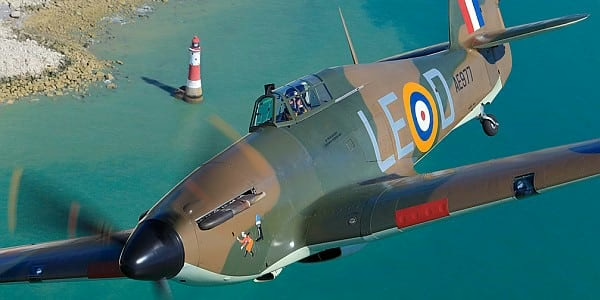Hawker Hurricane History
The Hawker Hurricane, surely the greatest among many excellent fighter designs evolved under the leadership of (Sir) Sydney Camm, was evolved initially to meet the requirements of Air Ministry Specification F.36/34, although preliminary discussion over the form that the new fighter should take had been held before this, in the late summer of 1933. A prototype (K5083) was completed during 1935, making its first flight on 6 November of that year. It was powered by the new 990 hp Rolls-Royce Merlin ‘C’ engine – itself not yet fully certified – and in the following March began its first service trials at Martlesham Heath. Results of these included a level speed of 315 mph (507 km/hr) and the ability to climb to 15,000 ft (4,572 m) in 5 min 42 sec, and with its fully-retractable landing gear and eight-gun intended armament the Hawker Hurricane clearly represented a radical change in the concept of RAF fighter design.
So confident were Hawkers in this new fighter that in March 1936 they authorised the start of work for the production of one thousand Hurricanes before a single order had been placed; their confidence was fully justified, for three month later, the Air Ministry contracted to purchase an initial quantity of six hundred. Some delay was occasioned by the decision to install the Merlin II engine in production Hurricanes, but the first of these (L1547) was eventually flown on 12 October 1937 and the first batch of completed fighters was delivered to No 111 Squadron at Northolt during the following month.
During the two immediate pre-war years, the Hawker Hurricane had undergone a number of developments. Metal-skinned wings replaced the original fabric covering (though fabric was still retained on the fuselage), improved three-blade propellers replaced the original two-blade wooden ones, the Merlin III superseded the Merlin II, and improved gun-sights and bullet-proof windscreen were fitted. Hawker had also flown, in May 1939, a Hurricane I with a 20 mm cannon beneath each wing. Proposals to install two of these guns in each wing had been made as early as February 1936, but rejected by the Air Ministry; later, however, this was to become the standard armament for wartime Hurricanes.
The Hawker Hurricane was a private venture to meet Specification F.5/34, revised to F.36/34, and the prototype, K5083, flew on November 6, 1935. An initial contract for 600 was increased to 1,000 in November 1938 and the first production aircraft, L1547, flew on October 12, 1937, incorporating some revisions.
The Hawker Hurricane and Supermarine Spitfire Battle of Britain roles are of course legendary, and both went on to be developed into various versions. Each type had its advantages, the Hurricane proving to be quicker to repair when battle-damaged, while the Spitfire had performance edge.
Production reached 12,711 Hawker Hurricane aircraft in Britain and more then 1,400 in Canada and the type served with nearly 150 RAF and Commonwealth squadrons, while Sea Hurricanes equipped 19 Fleet Air Arm squadrons.
Hawker Hurricane Specifications
| Aircraft Type: |
| fighter |
| Dimensions: |
| wingspan: 40 ft |
| length: 32 ft |
| height: 13 ft, 1 in |
| Weights: |
| empty: 5,800 lb |
| gross: 8,100 lb |
| Power plant: |
| 1 × 1,280 hp Rolls-Royce Merlin XX liquid-cooled in-line engine |
| Performance: |
| maximum speed: 336 mph |
| ceiling: 35,600 ft |
| maximum range: 460 mi |
| Armament: |
| 8 × 0.303 in calibre machine guns |
| up to 1,000 lb of bombs or rockets |
| Operational Use: |
| 1938–1945 |





